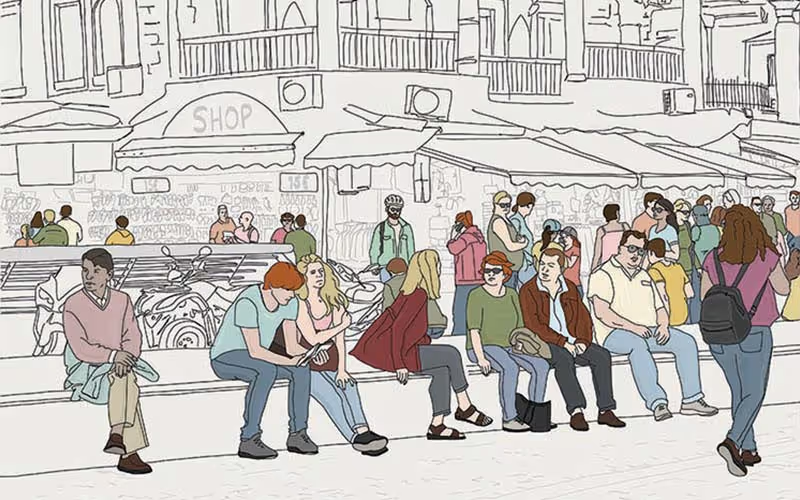My interest in the city bench after I took a trip to England and northern Europe in my first year of urban design to study public spaces. The main lesson I returned with to Canada was that people actually used them! Growing up in a small city and then moving to a larger city in the prairies, both with extreme climates and not a lot of urban areas, this was an amazing thing to me.
One specific public space that stuck with me from that trip is located outside the Roman Baths called Kingston Parade in Bath, England. The square itself is seemingly unremarkable in its design and materials i.e. no vegetation or trees, no central fountain, no accent paving pattern—just a square lined with rows of benches on all four sides. Yet, the space bursted with life: buskers, people reading books, couples drinking coffee in the sun, tourists taking photos, and a pack of urban design students who were trying to digest what they were looking at. This was the first time I really understood why the city bench is the unsung hero of the city.
How the city bench enhances public spaces
Since this experience, I have had ten years to observe and analyze how people use public space. I designed these spaces in school and then in professional practice. I now understand that it’s not the standard bench that solely deserves praise, but sittable public spaces in general that are created through the use of ledges, steps, terraces, planters, long group benches and loose chairs.
For the sake of this discussion, I will use the word ‘bench’ interchangeable with ‘sittable space’. Being a person who specifies seating products and designs areas for people to sit, it can be easy to get swept up in the programmatic goals, design aesthetics or project budget and forget the sociological impacts of benches. The Bench Project, published by The Young Foundation, a UK based non-profit think tank, clearly outlines a six-point manifesto that explains the social benefits of benches.
I have pulled three headings from The Bench Project to better illustrate the social and cultural importance of benches in our cities:
Benches are “public, egalitarian and free” (4)
The public bench is a welcoming and inclusive space for everyone and anyone to use. Edwin Heathcote explains in his article, Public benches: the seat of civilization, a bench is “a place to be private in public, a small space in the melee of the metropolis where it is acceptable to do nothing, to consume nothing, to just be”.
These types of truly public benches are becoming increasingly rare as anti-behaviour or “hostile architecture” techniques are standard in many cities in the form of sleep and skate deterrents along with a whole toolkit of ways to alter behaviour. The Bench Project research found that “not all forms of sitting in public are equal, and a broad ambition to keep urban precincts clean and safe can mean increased antipathy to human messiness” and warns not to “remove vegetation and public seating; to vandal, skateboard and sleep-proof the urban landscape into a dull sterile shadow of a pleasurable place” (4).
“Bench-space allows people to loosely belong within the flow of city life, to see and be seen” (6)
Urban design pioneers Jane Jacobs and William H. Whyte have emphasized the importance of people watching as critical for the safety and vitality of public space. Jacobs’ “eyes on the street” watching the “sidewalk ballet” is a well-known and well documented fundamental principal of urban design. The Bench Project discusses how “simply sitting, seeing and being seen in itself can provide a sense of belonging” and how regular bench-users “valued the mixture of solitude with mingling, [and] loosely interacting with others” (6).
To see and be seen, the bench location is essential for the user to feel like they are participating in the action, or “flow” of the city. Views to and from the road, the sidewalk, park space, surrounding businesses and houses are critical for people watching. I mean, you can’t people watch if there’s no one around!
“Sitting on benches supports healthy everyday routine by enabling people to spend longer outside” (8)
Spending time outdoors, even in a dense urban place, can have restorative and stress-reducing qualities. In my article, Attention: Have you gone outside lately?, I go into detail about how little time we spend outside (most Canadians spend less than two hours per week) and why it’s imperative that we change our habits. While seemingly simple enough, a well-placed bench can become the perfect spot to eat lunch, read a book or meet a friend, enabling its users to spend time outside that they otherwise normally wouldn’t have.
The Bench Project conducted research that shows how benches can “support local walking when personal mobility is limited” (3). It provides a place to rest, a destination on a daily route to sit and enjoy the outdoors and participate in street life, which is especially important for the elderly and people with limited mobility.
In conclusion
Of course, you can’t just install a bench on each corner and expect the above social outcomes to become realized. As The Bench Project report writes, “benches do not exist in isolation; their presence is related to issues of public space for sociability and accessibility. [Their] research highlights the role of benches in giving a choice to stay longer, with links to wellbeing and inclusion” (16).
Successful sittable spaces are supported by good landscape design and a well-connected site. I will leave you with an obvious, and yet, profound quote from William H. Whyte’s famous 1981 NOVA episode City Spaces, Human Places where he explains, “People tend to sit most where there are places to sit . . . The most attractive fountains, the most striking design, cannot induce people to come and sit where there are no places to sit”.


